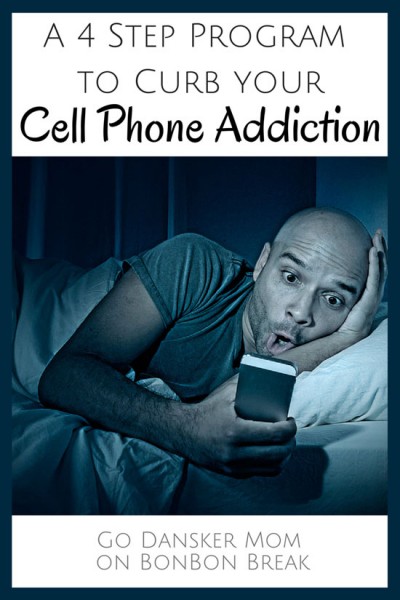A (Drastic) 4-Step Program to Curb that Phone Addiction

Let me give you the honest assessment straight up: our phones are a problem. For nearly all adults in my circles, we have a serious addiction to social media platforms, our emails, and those wily little smartphones.
Their neon glow lure us in with promises of making life smoother, easier, and more efficient. Yet I notice that my friends and me spend many precious minutes glued to them. They are the first things we look at when we wake up and the last things we check before sleeping. At the same time, more and more online articles are decrying the state of the hooked-in parent, the always-online society. More and more people are posting about their needs to unplug and disconnect. There is a whole day called “National Day of Unplugging” for us to “Unplug to Connect with Our Kids.”
Why is that phone such a seductive siren? Is it really making life easier or is it making life more chaotic?
I decided to see what I could do on my own, my little yet grand experiment. I wanted to see if it was possible to still use my smartphone and social media for what it was good for (which, do we even really know anymore?) while curbing my obvious addiction to it.
Over the past 3 weeks,, I have made a conscious effort to reassess my social media consumption. I know this is confusing given that my business is a blogger network for folks in North Carolina, I do content marketing for small businesses, and I freelance as a writer.
Point for social media: it gives me a paycheck.
Yet I found myself wildly obsessed with my phone in recent months in a way I didn’t like. It wasn’t ever a noticeable change that happened in a single instance but one day I casually grabbed my phone and looked for notifications at all the stoplights I hit on the way home. I even started reply to texts while driving…with my kids in the car. Put that one in the category of things I swore I would never do as a parent. After all, not only am I steward of leading a good example (do I want my kids to grow up to text and drive?) but I am, most importantly, a steward of their safety.
Point against social media: it is wildly addictive.
Yet what makes it so alluring? Why is it that I felt as though amazing things were going to happen between stop lights that required me to constantly check in?
Read this:
Dr Tom Stafford, a lecturer at the University of Sheffield and co-author of the book Mind Hacks, believes that the same fundamental learning mechanisms that drive gambling addicts are also at work in email users. “Both slot machines and email follow something called a ‘variable interval reinforcement schedule’,” he says, “which has been established as the way to train in the strongest habits. This means that rather than reward an action every time it is performed, you reward it sometimes, but not in a predictable way. So with email, usually when I check it there is nothing interesting, but every so often there’s something wonderful – an invite out, or maybe some juicy gossip – and I get a reward.” This is enough to make it difficult for us to resist checking email, even when we’ve only just looked. {source}
Email is as addictive as gambling?! I immediately thought, “That can’t be true.” But if I am honest, it kind of made sense, too. It actually explains why we all are so tuned in to it, why smartphones even exist. Some nagging feeling was telling me that this article was on to something.
I pressed and did more reading and research and found this article, published way back in 2010, by Harvard Business Review: ”Breaking the Email Addiction.” It starts by asking some serious questions:
Do you check email while you’re driving, even though you’re four times as likely to have an accident when you do?
Are you answering email on your iPhone or Blackberry when you walk between meetings, or on your way to the parking lot?
Yes and yes.
We’re pulled to anything that provides instant gratification, even when we know we’d get a bigger reward for delaying. We’re also quick to respond to any excuse to stop working on something that is difficult and requires high concentration.
Does this sound familiar to anyone else or is it just me? No, you know what, I will go ahead and point some fingers right now since I know I am not the only one out there looking at my phone at traffic lights. When I am not checking my phone I am looking at other drivers and guess what: they are checking their phones.
So it didn’t take long for the Internet to convince me that email and social media are addictive. But I still felt there was more to the “why” story. Instant gratification, sure, but I have always been the sort of person who can sit and stare at the marshmallow and not eat it. Why is it so different with electronic devices?
Susan Weinschenk, PhD, in her article on Psychology Today explains it this way:
Dopamine loops — With the internet, Twitter, and texting you now have almost instant gratification of your desire to seek. Want to talk to someone right away? Send a text and they respond in a few seconds. Want to look up some information? Just type your request into Google. Want to see what your colleagues are up to? Go to LinkedIn. It’s easy to get in a dopamine induced loop. Dopamine starts you seeking, then you get rewarded for the seeking which makes you seek more. It becomes harder and harder to stop looking at email, stop texting, or stop checking your cell phone to see if you have a message or a new text.
Oh, right. So that is a familiar sensation.
Now I am convinced. The pull of wanting to know what is going on in the Internet world, reading a funny post that makes me laugh, getting that reward, then wondering next time the device is off, “What am I missing right now?!” I feel that.
So it turns out that social media and email are as addictive as other vices we have “anonymous” programs for. The instant gratification quotient, the unpredictability of it, the fact that it can deliver wonderful things, that dopamine loop, it all teases our human natures to extremes.
Point against social media: it can require a support group to recover from.
Armed with the knowledge I needed to motivate me to change my habits, I decided to take some drastic steps.
In life we are always struggling for that silky word “balance,” are we not? I entered this experiment with the belief that limiting my social media consumption, cutting the tether between myself and my phone, would leave me more balanced and grounded in my life.
But first I had to actually cut that incredibly strong tether. Here are the steps I took:
Step 1: I removed the applications from my phone.
Yep, I uninstalled the Twitter app, Facebook app, Facebook messenger, and my email app. (I kept Instagram. There is a reason why going cold turkey is so hard for addicts.) I understand that apps make it easier for us to use these platforms and programs and appreciate the beauty in that. But what I needed to do, according to the Harvard Business Review, was figure out how to delay my instant gratification response.
Those apps gave me itchy swiping fingers. Every time I received a push notification alerting me to activity or responses or emails, I HAD to look. I couldn’t hear that “ding” and not look.
I also couldn’t let those notifications pile up. Once, on a beach weekend with my children, I vowed not to look. As I watched my Facebook notifications get up in the 70′s, I started to become stressed. At that point, Facebook’s push notifications to my phone were a reminder of what I was going to have to catch up on when I returned, or so I felt.
Yet, it was Facebook! What critical notifications was I to receive via Facebook that was life changing? Well, it turns out in my industry, Facebook messenger and Facebook groups provide a lot of value. Yet, not enough to require me to be booting up the app every time I got a little circle with a “1″ in it pop up.
Step 2: I installed a timer device on my Internet browser.
Yes, these exist. Chrome has an extension you can install called StayFocusd. It is remarkable how, once you start truly tracking it, you can see the staggering results of the sheer amount of actual minutes of your life you spend on these platforms. With data and numbers, it is hard to justify the activity.
Step 3: I set aside a limit and a time for being on social media and my computer.
I gave myself actual hours each day to be on my computer, blog, social media, and email. I wrote them down. I shared them with my business partner and spouse.
Then beyond that, if it doesn’t get done, it doesn’t get done. This has required me to have some honest conversations with myself about what needs to go. You see, if at the end of the week there is still a crushingly long list of things I need to do yet I have used up all my self-allotted computer time, then clearly I have too much on my list. Something needs go.
Step 4: We do not use computers or phones in our house from the hours of 4 pm – 7 pm.
I established this awhile ago. It drove me nuts to see my husband walk in from a long day at work and immediately check his email to see what had happened in the 40-minute drive home. I would get buggy-eyed and naggy. That said, I was also an offender. So we made a deal: that time was devoted to family and reconnecting with each other.
This gets a little complicated since I use my tablet as my reader. The saving grace of this digital-free time each day is that my tablet doesn’t work all that great so getting on the Internet or any social media is more of a device-crashing production than just opening up my Kindle reader.
Like I said, I still use Instagram, which remains my weakness. I love pretty pictures, and I love the creative element of finding beautiful and entertaining pictures to snap of my everyday life. It is a hobby, it is my documentation for my family’s future, and it helps me focus on the amazing. I also find that, for some reason, I don’t log into Instagram nearly as often as other social media platforms. That justifies that.
Those steps might not sound so drastic, but I found that a few times I had to physically put my phone in a drawer to keep from checking it or lock it in the console of our car while I was driving. Old habits are hard to break.
After 3 weeks, what have I learned?
I started to feel socially isolated. My social schedule hadn’t changed, but limiting the time I spent “liking” Friends’ photos, reading tweets from other human beings, clicking on blogs in my RSS reader, has made me feel as though my social activity has dropped immensely. Again, it hasn’t changed in any way except the virtual one.
This was eye opening, and clearly an indication to myself that maybe I need more “in real life” interactions to feel fulfilled as a person. I have always made it a point to go meet up with friends two to three times a week, in some fashion or another, and my husband and I have regular bi-weekly date nights in addition to PTA meetings, board meetings, work meetings, and so forth. But clearly something is still missing for me if social media was filling a noticeable void. I have some work to do.
Point for social media: it can stave off isolation.
Another eye opening realization is that the hardest platform to let go of is Twitter. I thought I would miss Facebook more than anything, but when it comes to my job and social media, Twitter is an issue. Twitter moves so fast and response time expectations are much quicker than other platforms.
And this leads me to add that, in general, the response time expectations in our society are overwhelmingly crushing. Emails are expected to be responded to within 24 hours, if not sooner. Which, when you sit down to your email only three times a day, that can be frustrating and nearly tear-inducing. So much business is conducted via email now, both personal and professional. My emails stack up in hours to an amount that I can’t get through in a decent amount of time no matter who I am. I know this isn’t new news, and on some levels I already understood this, but engaging in my experiment it became abundantly clear how email-dependent nearly all facets of adult life are. I want out of that.
So what about balance? Did I find it?
Not exactly. I won’t say I have more “balance.” I still want more of that ever-escaping “Me Time” and I haven’t sewn, crafted, or written creatively for months, even with my 3-week experiment.
But I feel comforted. There was a powerful moment in my life recently when Danielle Smith of Extraordinary Mommy stood up in front of a crowded room of bloggers and said that there isn’t such a thing as balance and we should all stop chasing it. The fact is that we simply can’t do multiple things at once. We can’t be on social media while being a good parent and we can’t be good at our jobs while simultaneously trying to parent. It makes sense but no one ever actually says this.
My experiment helped me learn this in a raw way. It should be said that I heard Danielle say these words in the middle of my new habits journey. Her words pinpointed the emotions I was feeling, the struggle I was having, but also the freedom I was discovering.
By curbing my addictions, getting my gratification impulses under control, and stopping the dopamine loop, I find that I am better at what I am doing in the moment.
I am not, by any means, wildly advocating a call for moms to put down their phones while at the playground. I think that life and parenting is far too complicated for that. Instead, I am saying that taking a conscious and metered look at controlling phone and social media consumption has been redemptive for me.
Now, when I am with my kids, I am down on the floor with them, in it. I am not also listening for the “ping” and checking my emails while trying to help them through a puzzle.
When I know I need to take my allotted time to be on my computer, scheduling tweets, responding to messages in Facebook groups, I am focused and I feel accomplished when I get up. Also, I don’t feel guilty when I pick up my phone because I know it is my allowed time. I planned for it, it is okay.
This has been amazing, especially given that my New Years Resolution for 2014 was an ambiguous word choice: to be “HERE” more. This is my answer. I still might allow my mind to drift to things I should be doing while I am not doing those things, but that is my cross to bear and I have always dealt with that as a character flaw. What scheduling my phone activities and throwing that thing in my car’s console has done is helped me not add more things to my list as I check in.
I feel so much better. I feel lighter, more free, and more focused on my priorities. I may still be an addict, but at least I am on my way to recovery.
READ MORE IN THE FAMILY ROOM
PIN FOR LATER





